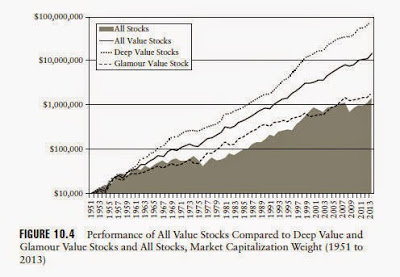Tobias E. Carlisle, co-author of a book I put on investors’ “must read” list—Quantitative Value, is back with another compelling volume, Deep Value: Why Activist Investors and Other Contrarians Battle for Control of “Losing” Corporations (Wiley, 2014).
The most public face of deep value investing is Carl Icahn, known for his “battering-ram personality,” who has had a long, storied career as a discount options broker, arbitrageur and liquidator of closed-end mutual funds, corporate raider, and activist investor. In 1976 he wrote a memorandum, which his biographer dubbed the “Icahn Manifesto,” in which he stated: “It is our contention that sizeable profits can be earned by taking large positions in ‘undervalued’ stocks and then attempting to control the destinies of the companies in question by: a) trying to convince management to liquidate or sell the company to a ‘white knight’; b) waging a proxy contest; c) making a tender offer and/or; d) selling back our position to the company.” (p. 4) By the way, the last option, known as greenmail, in which the company in effect pays a ransom by buying back the raider’s stock at a premium to the market price, is now illegal.
Few people have the qualities necessary to be the next Carl Icahn. But they can still profit from the well tested principles of deep value investing.
Carlisle traces out the evolution of deep value investing, beginning with Benjamin Graham’s notion of net nets, companies whose “market capitalization was net of the net current asset value.” That is, these companies had a surplus of current assets (cash, receivables, and inventory) over all liabilities (current and long term) and had market capitalizations no higher than two-thirds of their net current asset value.
Warren Buffett viewed the acquisition of net nets as foolish “unless you are a liquidator.” He essentially rejected deep value investing with its strictly quantitative metrics and its cigar butt investment philosophy. He incorporated qualitative considerations into his company analyses and famously said that “It’s far better to buy a wonderful company at a fair price than a fair company at a wonderful price.”
Carlisle aligns himself more with Graham than with Buffett, in large part because he believes there is compelling evidence for mean reversion in stocks. His firm, Eyquem Investment Management, examined returns of the top 50% of stocks by market cap in 23 developed-market countries from 1980 to 2013. Each stock was sorted according to its ratio of market price-to-book value, cash flow, and earnings. The sorted stocks were then divided into five quintile portfolios, fifteen portfolios in all. No matter which ratio one looks at, the average annualized five-year returns of the value portfolio end up in quintile 5 (c. 13-14%) and those of the glamour stocks in quintile 1 (c. 8-9%). The most sensitive ratio was price-to-cash flow; glamour stocks performed worst and value stocks best when sorted on this metric.
Carlisle admits that the value premium also seems to mean revert; recently value has underperformed glamour. The level of underperformance from 2010 to 2013 is perhaps payback for the huge outperformance from 2000 to 2005, and this outperformance may be attributable to the underperformance of value stocks in the late 1990s. Over the long haul, however, value stocks beat both the market and glamour stocks.
The graph below shows the annual returns of the largest 40% of U.S. stocks by market cap from 1951 to 2013. The value portfolio comprised one tenth of the All Stocks universe (c. 114 of 1,140). This portfolio was further subdivided. The cheaper half of the value decile, those with the highest ratio of EBIT to enterprise value, is the Deep Value Stocks portfolio; the more expensive half is the Glamour Value Stocks portfolio. The Deep Value portfolio saw a compound annual growth rate of 15.72%; the Glamour Value portfolio, 8.84%.
I don’t want to give the impression that Carlisle’s book is simply a bunch of numbers and charts. Far from it. It recounts famous deals and portrays successful deep value investors, which makes it an enjoyable read. But the most important takeaways—and why the book is worth careful study, not just a quick read—are that “valuation is more important than the trend in earnings” and, counterintuitively, that, “even in the value portfolios, high growth leads to underperformance, and low or no growth leads to outperformance.” (p. 211) In brief, contrarianism pays off.
- English (UK)
- English (India)
- English (Canada)
- English (Australia)
- English (South Africa)
- English (Philippines)
- English (Nigeria)
- Deutsch
- Español (España)
- Español (México)
- Français
- Italiano
- Nederlands
- Português (Portugal)
- Polski
- Português (Brasil)
- Русский
- Türkçe
- العربية
- Ελληνικά
- Svenska
- Suomi
- עברית
- 日本語
- 한국어
- 简体中文
- 繁體中文
- Bahasa Indonesia
- Bahasa Melayu
- ไทย
- Tiếng Việt
- हिंदी
Book Review: Deep Value
Published 09/02/2014, 05:57 AM
Updated 07/09/2023, 06:31 AM
Book Review: Deep Value
Latest comments
Install Our App
Risk Disclosure: Trading in financial instruments and/or cryptocurrencies involves high risks including the risk of losing some, or all, of your investment amount, and may not be suitable for all investors. Prices of cryptocurrencies are extremely volatile and may be affected by external factors such as financial, regulatory or political events. Trading on margin increases the financial risks.
Before deciding to trade in financial instrument or cryptocurrencies you should be fully informed of the risks and costs associated with trading the financial markets, carefully consider your investment objectives, level of experience, and risk appetite, and seek professional advice where needed.
Fusion Media would like to remind you that the data contained in this website is not necessarily real-time nor accurate. The data and prices on the website are not necessarily provided by any market or exchange, but may be provided by market makers, and so prices may not be accurate and may differ from the actual price at any given market, meaning prices are indicative and not appropriate for trading purposes. Fusion Media and any provider of the data contained in this website will not accept liability for any loss or damage as a result of your trading, or your reliance on the information contained within this website.
It is prohibited to use, store, reproduce, display, modify, transmit or distribute the data contained in this website without the explicit prior written permission of Fusion Media and/or the data provider. All intellectual property rights are reserved by the providers and/or the exchange providing the data contained in this website.
Fusion Media may be compensated by the advertisers that appear on the website, based on your interaction with the advertisements or advertisers.
Before deciding to trade in financial instrument or cryptocurrencies you should be fully informed of the risks and costs associated with trading the financial markets, carefully consider your investment objectives, level of experience, and risk appetite, and seek professional advice where needed.
Fusion Media would like to remind you that the data contained in this website is not necessarily real-time nor accurate. The data and prices on the website are not necessarily provided by any market or exchange, but may be provided by market makers, and so prices may not be accurate and may differ from the actual price at any given market, meaning prices are indicative and not appropriate for trading purposes. Fusion Media and any provider of the data contained in this website will not accept liability for any loss or damage as a result of your trading, or your reliance on the information contained within this website.
It is prohibited to use, store, reproduce, display, modify, transmit or distribute the data contained in this website without the explicit prior written permission of Fusion Media and/or the data provider. All intellectual property rights are reserved by the providers and/or the exchange providing the data contained in this website.
Fusion Media may be compensated by the advertisers that appear on the website, based on your interaction with the advertisements or advertisers.
© 2007-2024 - Fusion Media Limited. All Rights Reserved.
